A jigging reel is a specialized type of fishing reel designed for a specific fishing technique known as jigging. Jigging is a fishing method that involves vertically dropping a lure or jig into the water and then jerking or bouncing it up and down to attract fish. The primary purpose of a jigging reel is to facilitate this technique by providing anglers with the necessary features and functionality.
Jigging reels are distinct from other types of fishing reels, such as spinning reels or baitcasting reels, as they are specifically engineered to handle the demands of jigging. These reels are built to be durable, offer precise control, and provide the power needed to handle the often deep-water environments where jigging is commonly practiced.
By using a jigging reel, anglers can effectively target a wide range of species, including saltwater game fish like tuna, grouper, and snapper, as well as freshwater species like walleye and bass. The unique design and features of jigging reels make them well-suited for this fishing technique, allowing anglers to manipulate their lures with precision and entice strikes from the depths.
As you continue reading this article, we will explore the key components, types, techniques, and tips related to jigging reels, providing you with a comprehensive understanding of this specialized fishing gear. Let’s dive into the exciting world of jigging and discover the advantages and applications of these reels!
Different Types of Jigging
Conventional Jigging Reels
Conventional jigging reels, also known as overhead reels, are the traditional choice for jigging. They feature a horizontal spool and a handle on the side of the reel. These reels are popular among experienced anglers who prefer precise control and power when jigging.
Conventional jigging reels are designed to handle heavy lines and large fish. They offer a higher line capacity compared to spinning reels, allowing anglers to use thicker lines required for targeting big game fish. The drag system in conventional reels is robust and capable of handling strong and aggressive fish species.
One of the key advantages of conventional jigging reels is their ability to provide significant cranking power, enabling anglers to reel in fish from deep waters efficiently. The gear ratios in these reels are often higher, allowing for faster retrieval rates.
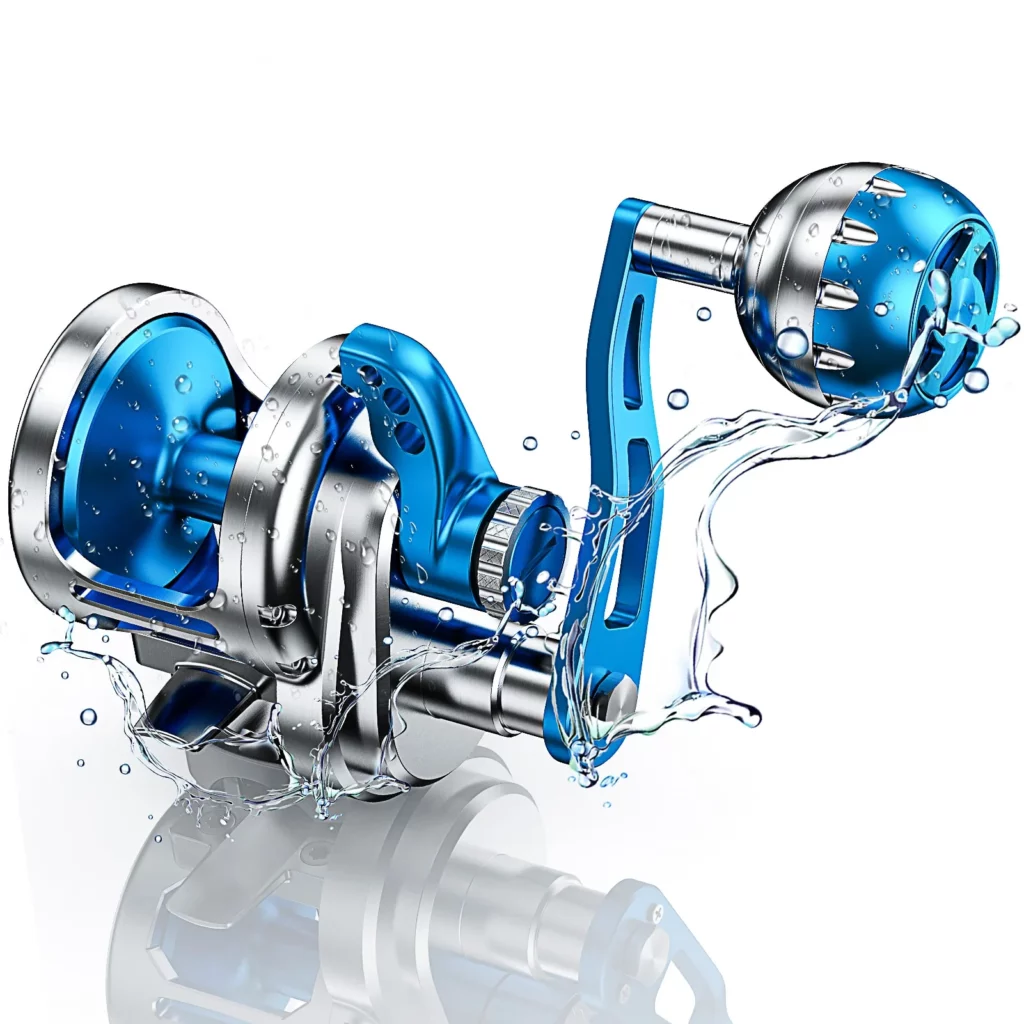
Spinning Jigging Reels
Spinning jigging reels, also known as spinning reels or fixed spool reels, have a vertical spool design and a fixed, forward-facing reel handle. These reels are popular among both beginners and experienced anglers due to their ease of use and versatility.
Spinning jigging reels are known for their smooth and precise drag systems, making them ideal for finesse jigging techniques. They offer excellent control and allow anglers to manipulate the jig with subtle movements. The vertical spool design reduces line twist, providing better casting distance and accuracy.
These reels are generally lighter and more compact than conventional jigging reels, making them more comfortable to handle during extended fishing sessions. Spinning reels are suitable for lighter lines and smaller fish species, although they can still handle medium-sized game fish.
Additionally, spinning jigging reels often have a lower gear ratio, providing increased torque for battling fish. They also offer a bail system that allows for easy line management and tangle-free casting.
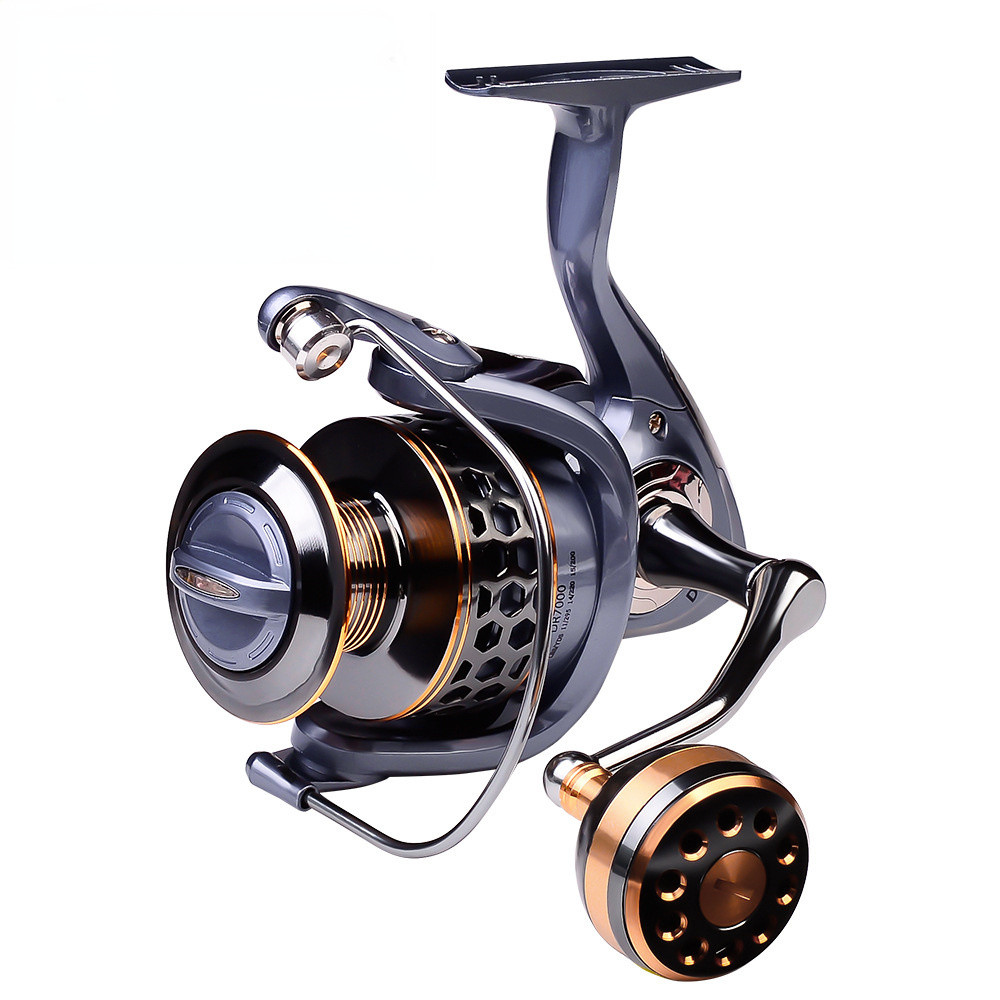
conclusion:If you like to fish in saltwater, then I still recommend Conventional Jigging Reels, especially if you’re hunting for big fish!
The main components and parts of jigging reel
Handles
The handle of a jigging reel is used to retrieve the line and plays a crucial role in controlling the jigging action. Handles can come in different designs and materials, such as aluminum or wood handle, providing anglers with comfort and a secure grip during intense jigging movements.
Our topline jigging reel offers jigging reel (TC) for aluminum alloy handle and jigging reel (TF) for wooden oval hadnle, and our TC products are more popular on Alibaba and Amazon.
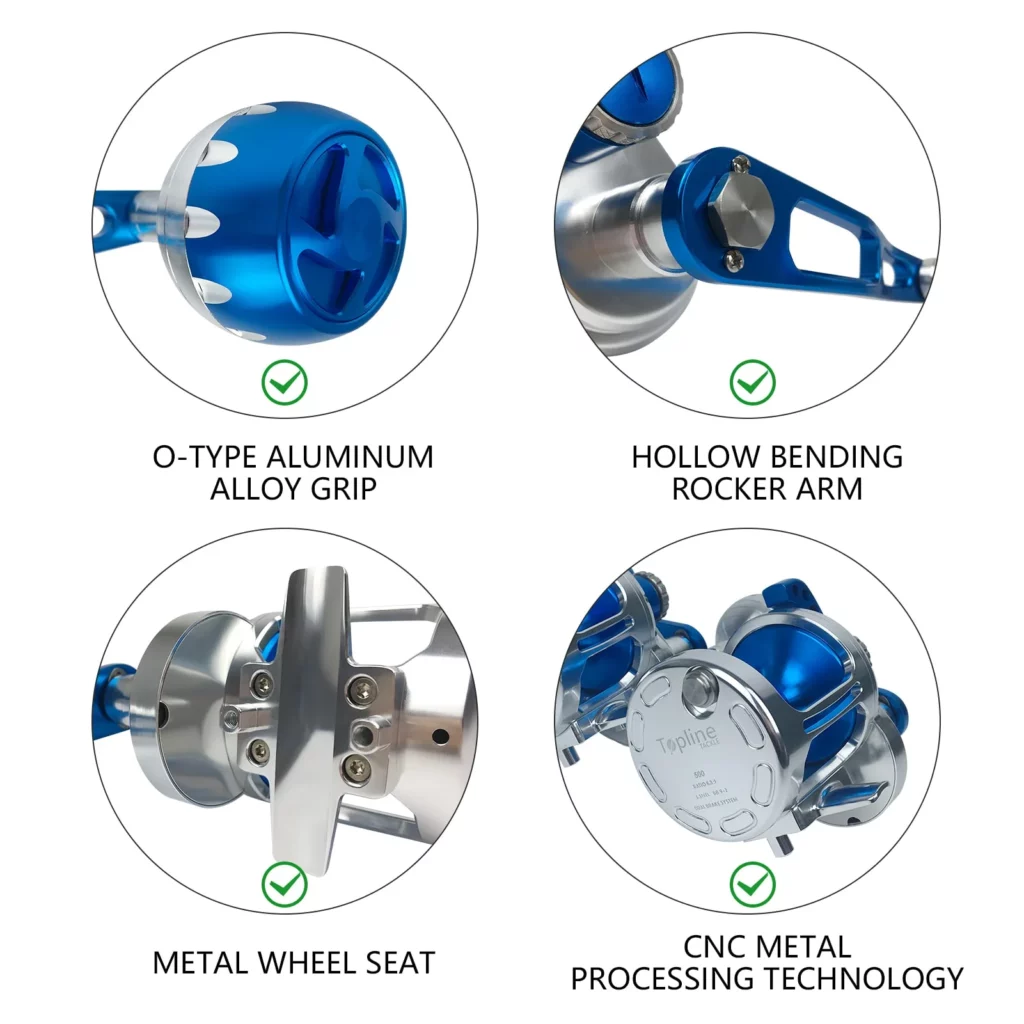
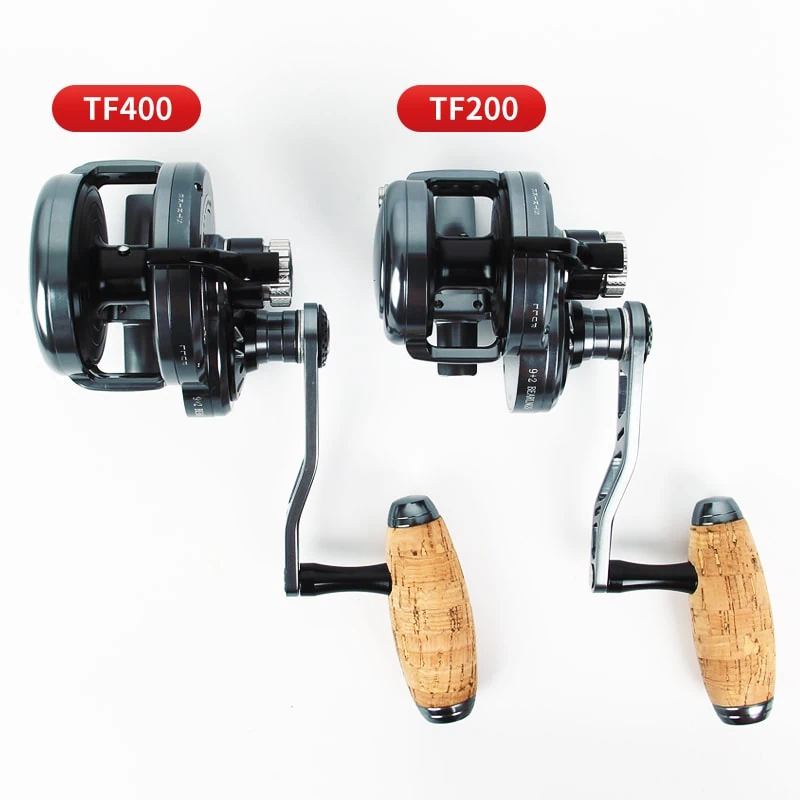
Brake System
The brake system in a jigging reel is crucial for maintaining casting accuracy, controlling line tangles, and achieving optimal casting distance. By utilizing the appropriate brake settings, anglers can effectively control the spool’s rotation and ensure smooth, controlled casts, which are especially important when targeting fish in deep water or when precision casting is required for successful jigging.

Spools and Line Capacity:
Jigging reels typically have robust spools designed to handle heavier lines. The spool is where the fishing line is wound. It can be made of materials like aluminum or graphite to provide strength and durability. Line capacity refers to the amount of line a spool can hold, typically measured in pounds or meters. Jigging reels often have higher line capacities to accommodate thicker lines needed for targeting larger fish species.
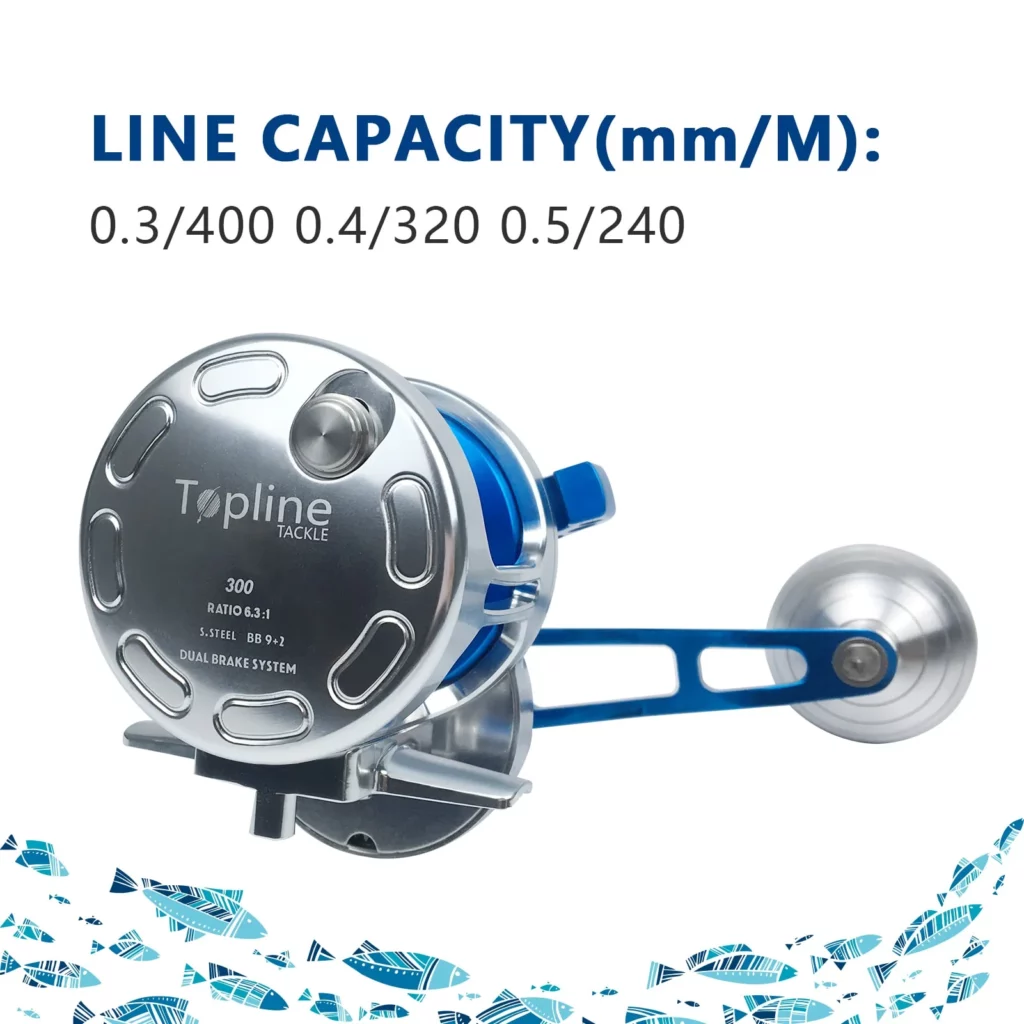
Gear Ratios
The gear ratio of a jigging reel determines how quickly the line is retrieved with each turn of the handle. Jigging reels usually have gear ratios that strike a balance between power and speed. A higher gear ratio, such as 6.3:1, enables faster line retrieval, which is advantageous when trying to keep up with rapidly ascending or fleeing fish. Lower gear ratios, such as 4.2:1, provide increased torque and pulling power for lifting heavy jigs or battling stubborn fish.
The gear ratio of our topline slow pitch jigging reel is 6.3:1, which is also the optimal gear ratio for slow jigging. We will explain the difference between slow jigging and fast jigging later.
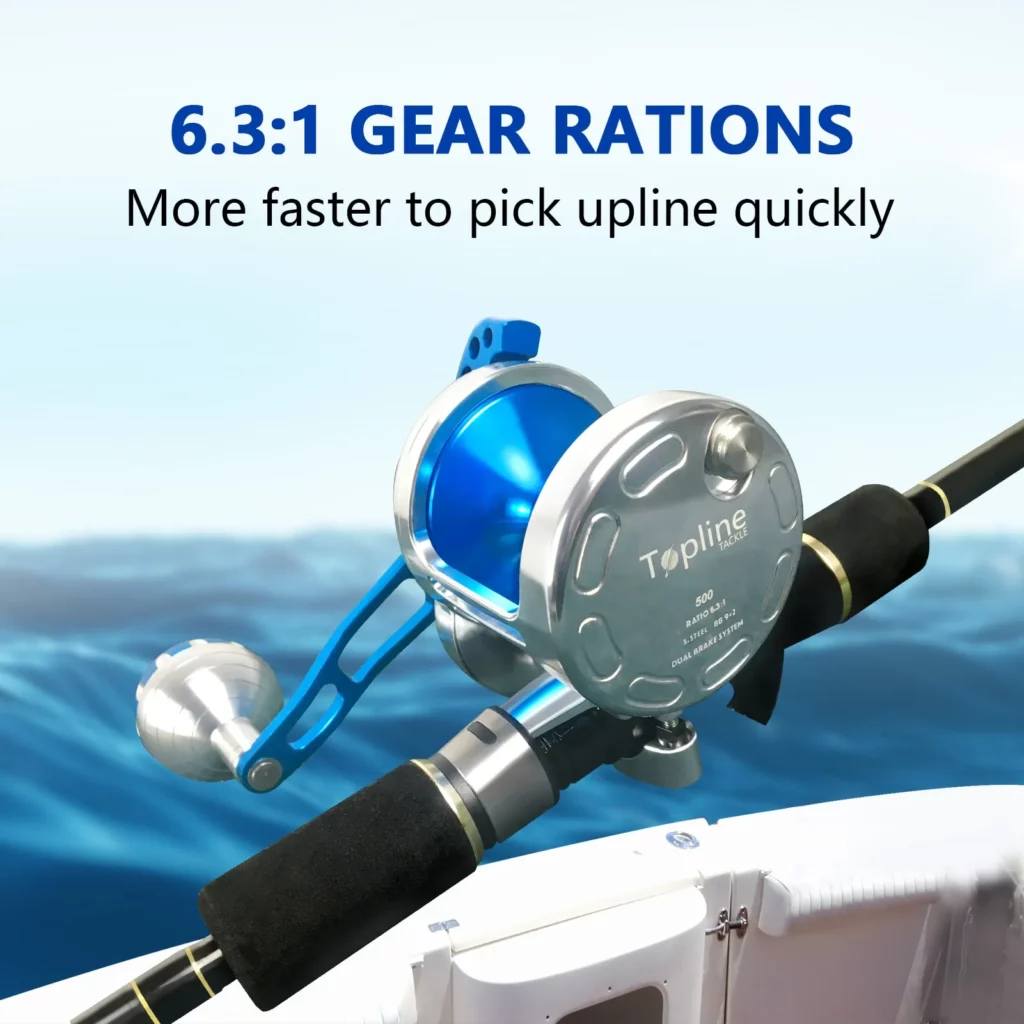
Bearings
The ball bearings in a jigging reel are crucial for its smooth operation and overall performance. Among various options, the “9BB+2RB” configuration is widely considered the best choice. With nine ball bearings and two roller bearings, this configuration ensures optimal performance, durability, and stability. The ball bearings reduce friction, allowing for effortless rotation of the reel’s moving parts. The additional roller bearings contribute to enhanced stability and weight distribution. The “9BB+2RB” setup offers a balanced combination of smoothness and reliability, providing anglers with a superior fishing experience. When choosing a jigging reel, opting for the “9BB+2RB” ball bearing configuration ensures maximum performance and durability, making it the preferred choice among anglers.
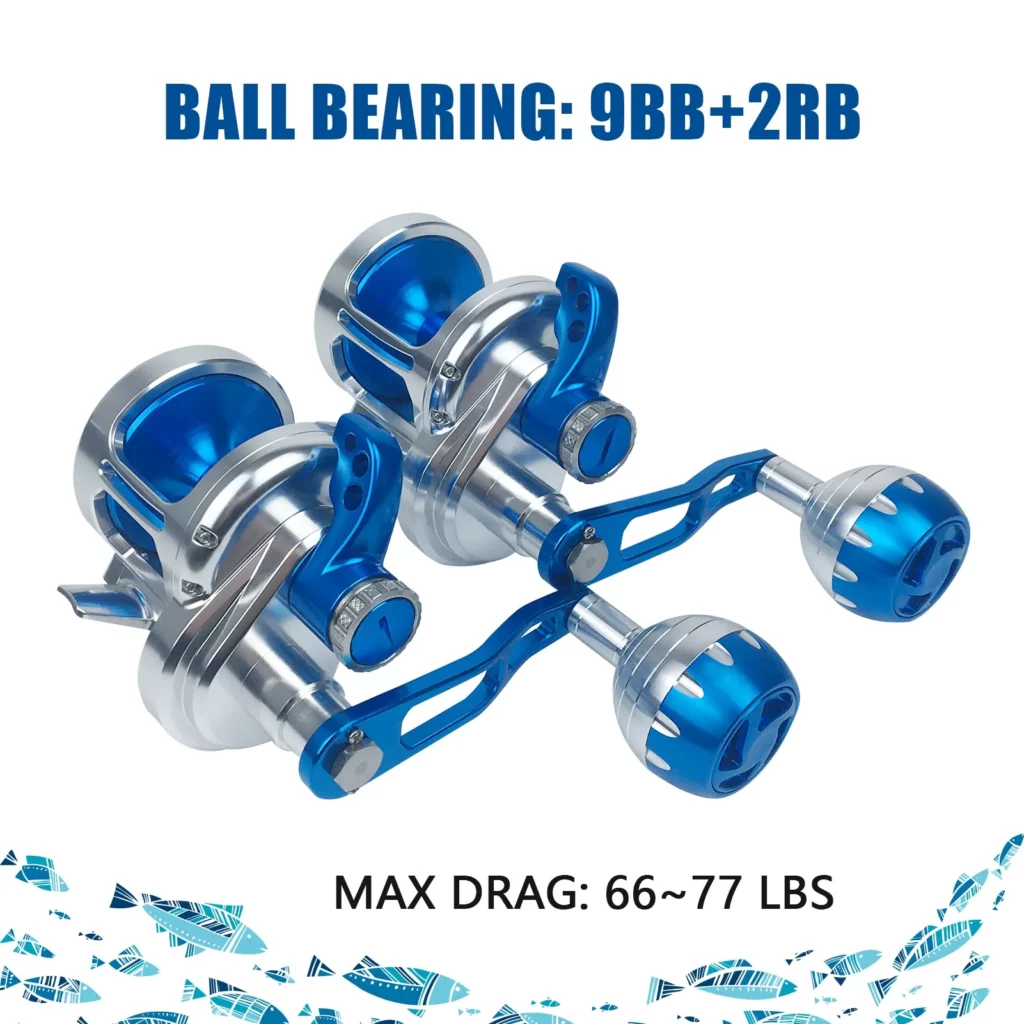
The Difference Between Slow Jigging and Fast Jigging
Slow jigging and fast jigging are two distinct fishing techniques with differing characteristics.
Slow jigging involves a deliberate and methodical jigging motion. Anglers use slower and controlled movements to entice fish that are less active or in colder water conditions. The goal is to present the jig in a subtle and enticing manner, enticing bites from finicky or less aggressive fish. Slow jigging requires precision and finesse to achieve optimal results.
Fast jigging, on the other hand, is a more aggressive and rapid jigging technique. Anglers employ rapid and vigorous movements to mimic the fleeing or injured behavior of prey, triggering aggressive strikes from fast-swimming and aggressive species. Fast jigging is characterized by quick repositioning of the jig and repeated action to create a sense of urgency.
For slow jigging, a gear ratio of 7.5:1 to 8.3:1 is not typically recommended. The higher gear ratio is better suited for fast jigging techniques that require quick line retrieval. Slow jigging requires a more controlled and deliberate approach, which is best achieved with a lower gear ratio like 6.3:1. The lower ratio provides increased torque, allowing anglers to effectively work the jig in a slow and precise manner, enticing bites from cautious fish.
The experiments of our buyers proved that 6.3:1 is the best gear ratio, it is not only suitable for slow jigging but also fast jigging.It offers the most balanced performance, which is why the TC jigging reel is the best seller.
How to Maintenance and Care your jigging reel
- Rinse with freshwater: After each use, rinse your jigging reel with freshwater to remove any salt, sand, or debris that may have accumulated. This helps prevent corrosion and damage to the reel’s components. Pay close attention to areas such as the spool, handle, and drag system.
- Dry thoroughly: After rinsing, make sure to dry your jigging reel thoroughly before storing it. Use a clean cloth or towel to remove any remaining moisture. Moisture can lead to rust and other forms of damage, so ensuring the reel is completely dry is crucial.
- Lubricate moving parts: Regularly lubricate the moving parts of your jigging reel to maintain smooth operation. Apply a small amount of reel oil or grease to the handle, gears, bearings, and other points of contact. This helps reduce friction and prolongs the lifespan of the reel.
- Check and tighten screws: Periodically inspect the screws and fasteners on your jigging reel to ensure they are secure. If you notice any loose screws, tighten them gently using the appropriate tools. Loose screws can affect the reel’s stability and performance.
- Store properly: When not in use, store your jigging reel in a cool, dry place away from direct sunlight and extreme temperatures. Consider using a reel bag or case to protect it from dust, moisture, and potential impacts.
- Regular maintenance: Schedule regular maintenance for your jigging reel, including deeper cleaning and thorough inspection. Depending on your usage frequency and fishing conditions, this could be done annually or more frequently. Consult the manufacturer’s instructions or seek professional assistance if needed.
If you also want to know how to clean lures, you can read my previous article “How To Clean Saltwater Fishing Lures“
Conclusion about Jigging Reel
In conclusion, a jigging reel is an essential tool for anglers practicing jigging techniques. Understanding the different components and features of jigging reels, such as handles, drag systems, spools, gear ratios, bearings, and maintenance, is crucial for making an informed purchasing decision and ensuring optimal performance.
Among the various options available, the Topline Slow Pitch Jigging Reel 66lbs Slow Jigging Reel Saltwater 6.3:1 9BB+2RB Jigging Reel stands out as a top-quality product. With its durable all-metal aluminum alloy construction, high-quality bearings, ergonomic design, and pre-set lever drag features, it offers exceptional performance and reliability.
The 6.3:1 gear ratio of this jigging reel strikes a balance between slow and fast jigging techniques, making it versatile for different fishing styles. Additionally, the 9BB+2RB ball bearing configuration ensures smooth operation and durability, enhancing the overall fishing experience.
For anglers seeking a high-performance jigging reel with excellent features, the Topline Slow Pitch Jigging Reel 66lbs Slow Jigging Reel Saltwater 6.3:1 9BB+2RB Jigging Reel is the best choice. It combines durability, functionality, and value, making it a top-notch option for both amateur and experienced anglers.
FAQS about Jigging Reel
Q: How important is the gear ratio in a Jigging Reel?
A: The gear ratio is crucial in a Jigging Reel as it determines the speed at which you can retrieve your line. A higher gear ratio, such as 6.3:1, means faster line retrieval, allowing you to work your jigs more efficiently and cover a larger area in a shorter amount of time.
Q: What does 9BB+2RB mean in the specifications of a Jigging Reel?
A: 9BB+2RB refers to the number of ball bearings (BB) and roller bearings (RB) in the Jigging Reel. More bearings generally result in smoother operation, increased durability, and better performance overall.
Q: Is the Slow Jigging Reel suitable for saltwater fishing?
A: Yes, the Slow Jigging Reel is specifically designed for saltwater fishing. It is constructed with corrosion-resistant materials and components to withstand the harsh conditions of saltwater environments, ensuring its durability and longevity.
Q: How much weight can the Slow Pitch Jigging Reel handle?
A: The Slow Pitch Jigging Reel is capable of handling up to 66 lbs (pounds) of weight. But our topline products can reach up to 77lbs. This high weight capacity makes it suitable for targeting large and powerful fish species commonly found in saltwater environments.
Q: What makes the Slow Pitch Jigging Reel the best product in its category?
A: The Slow Pitch Jigging Reel stands out as the best product due to its combination of features and performance. With a high gear ratio of 6.3:1, 9BB+2RB bearings for smooth operation, and a strong drag system, it offers anglers the necessary tools for effective slow pitch jigging in saltwater environments.
Q: Can the Slow Pitch Jigging Reel be used for other fishing techniques?
A: While the Slow Pitch Jigging Reel is primarily designed for slow pitch jigging, it can also be used for other vertical jigging techniques and bottom fishing. Its high gear ratio and strong drag system make it versatile enough to handle different fishing styles and tech niques. Our topline products provide warranty and free return service.
Q: Are spare parts and repairs easily available for the Slow Pitch Jigging Reel?
A: Yes, spare parts and repairs for the Slow Pitch Jigging Reel are generally readily available. It’s always a good idea to check with the manufacturer or authorized dealers to ensure you have access to spare parts and reliable repair services if needed.
Q: Where can I purchase the Slow Pitch Jigging Reel?
A: The Slow Pitch Jigging Reel can be purchased online through various fishing gear retailers or directly from the manufacturer’s website. It’s recommended to check reputable online marketplaces, fishing tackle stores, or the manufacturer’s official channels.Topline Tackle might be your best bet . It is sold on Amazon, AliExpress and Alibaba, but I still recommend you to buy his products on the official website(toplinefishingtackle.com).

